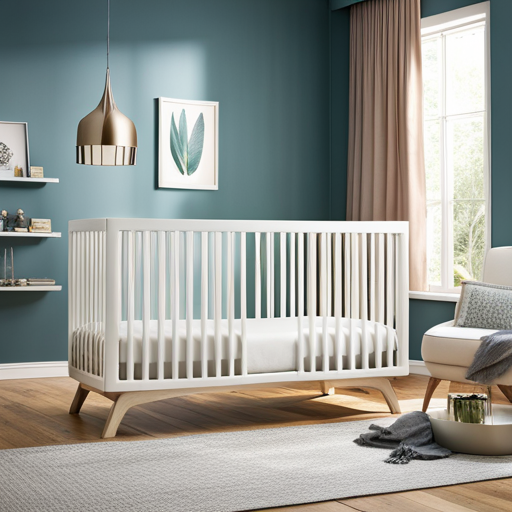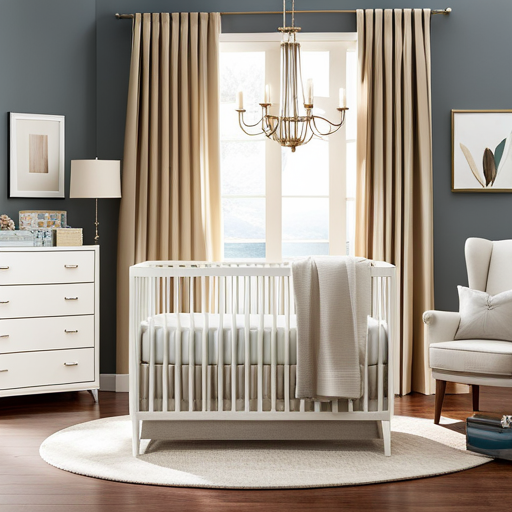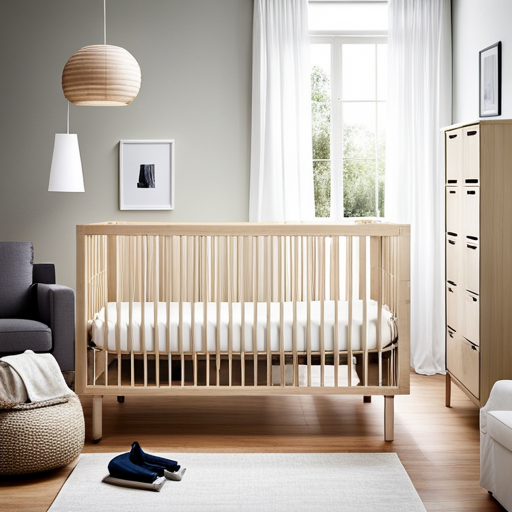Bed for Baby
Looking for the perfect bed for your little bundle of joy? Well, look no further! In this article, we’ve got all the insider tips and tricks to help you find the ideal bedding for your baby.
From choosing the right crib to safety measures you need to know, we’ve got you covered.
Plus, we’ll even share some co-sleeping options and advice on transitioning to a toddler bed when the time comes.
So sit back, relax, and let us guide you through this exciting journey of finding the perfect bed for your precious baby.
Key Takeaways
- Prioritize safety and comfort when selecting baby bedding materials
- Choose a snug-fitting crib sheet and remove pillows, blankets, and stuffed animals
- Ensure the crib meets safety standards and has a firm mattress
- Use a waterproof mattress cover for easy cleanup
Choosing the Right Bedding
You should choose the right bedding for your baby’s bed. When it comes to baby bedding materials, safety and comfort should be your top priorities. Look for bedding made from natural fibers like cotton or bamboo, as they are breathable and gentle on your baby’s sensitive skin. Avoid synthetic fabrics that may cause allergies or irritate their delicate skin.
Decorating the nursery with bedding is a fun and exciting part of preparing for your little one’s arrival. Choose colors and patterns that create a soothing and calming environment. Soft pastel shades like light blue, pink, or yellow are popular choices for nurseries. Opt for designs featuring cute animals, stars, or floral prints to add a touch of whimsy to the room.
It’s important to remember that simplicity is key when it comes to baby bedding. Avoid using too many pillows, blankets, or crib bumpers as they can pose suffocation hazards for infants. Instead, opt for a fitted sheet that securely covers the mattress.
Safety Tips for Baby’s Bed
When setting up your little one’s crib, ensure it meets the necessary safety standards. Baby bed safety is of utmost importance to protect your precious bundle of joy. One essential aspect to consider is the crib mattress. It plays a vital role in providing a safe and comfortable sleeping environment for your baby.
First and foremost, always choose a firm mattress that fits snugly into the crib. This prevents any gaps between the mattress and the sides of the crib where your baby could potentially get trapped. Additionally, make sure that the mattress is free from any tears, cracks, or peeling vinyl coverings as they can pose suffocation hazards.
Another crucial consideration is selecting a waterproof mattress cover. Babies are known for their occasional accidents, and having a waterproof cover ensures easy cleanup while maintaining hygiene.
Regularly inspecting the crib mattress for wear and tear is also important. As your little one grows, they may start jumping or standing in their crib, which can cause wear on the mattress over time. If you notice any signs of deterioration such as sagging or lumps, it’s time to replace it with a new one.
Types of Cribs for Newborns
To ensure a safe and comfortable sleeping space, consider different types of cribs for your newborn.
When it comes to choosing the right crib for your baby, there are a few factors you should keep in mind. First and foremost, make sure the crib meets all safety standards and regulations. Look for cribs that have adjustable mattress heights so you can lower it as your baby grows. This will prevent them from climbing out of the crib and potentially getting injured.
Another important aspect to consider is the type of mattress you choose for the crib. Opt for a firm and breathable crib mattress to reduce the risk of suffocation or SIDS (Sudden Infant Death Syndrome).
Additionally, if you are short on space or frequently travel with your baby, portable cribs can be a great option. They are lightweight, easy to fold up, and can be moved around easily. Portable cribs provide a convenient solution without compromising on safety or comfort for your little one.
Co-Sleeping Options for Infants
Co-sleeping can be a suitable option for parents who want to keep their infant close during the night. It is a practice where the baby sleeps in close proximity to one or both parents, either in the same bed or within arm’s reach. Co-sleeping offers numerous benefits for both parents and infants, fostering a strong sense of security and emotional bond between them.
Babies who co-sleep tend to breastfeed more easily, leading to better nutrition and enhanced mother-child connection.
However, it is important to consider the potential risks associated with co-sleeping. One major concern is accidental suffocation or strangulation if the baby becomes trapped between pillows, blankets, or other bedding materials. To mitigate these risks, it is crucial to ensure a safe sleeping environment by using firm mattresses without gaps and keeping pillows and heavy covers away from the infant.
Additionally, co-sleeping may increase the risk of sudden infant death syndrome (SIDS) if certain safety guidelines are not followed. Parents should avoid consuming alcohol or drugs that impair their awareness while co-sleeping with their baby. It is also advised not to smoke around the baby or allow others who smoke near them.
Transitioning to a Toddler Bed
If you’re considering transitioning your little one to a toddler bed, it’s important to ensure their safety and create a comfortable sleep environment. Moving from a crib to a toddler bed can be an exciting milestone for both you and your child, but it’s essential to take certain steps to make the transition smooth and safe.
One crucial aspect of transitioning is establishing a nighttime routine. A consistent routine before bed helps signal to your child that it’s time to wind down and prepare for sleep. This can include activities such as reading books, taking a bath, or gentle cuddling. By incorporating these activities into their nightly routine, you are helping them establish healthy sleep habits.
Another helpful tool during this transition is sleep training. Sleep training methods can vary depending on the age and temperament of your child, but the goal is to help them learn how to fall asleep independently in their new bed. This may involve gradually reducing bedtime assistance or using techniques like timed check-ins.
Creating a comfortable sleep environment is also vital for successful transitioning. Make sure the mattress is firm yet supportive, with fitted sheets that fit snugly around all corners. Consider using safety rails on the sides of the bed to prevent accidental falls during the night.
Remember that every child is different, so be patient and understanding throughout this process. With love, consistency, and some adjustments along the way, your little one will soon be sleeping soundly in their new toddler bed.
Frequently Asked Questions
What Are Some Common Signs That Indicate a Baby Is Ready to Transition to a Toddler Bed?
Common signs that indicate your baby is ready to transition to a toddler bed include climbing out of the crib, showing interest in big kid beds, and being able to follow simple instructions.
Are There Any Specific Safety Guidelines for Using Crib Bumpers or Bedding Sets?
When it comes to crib bumpers and bedding sets for babies, safety is paramount. Follow these guidelines: avoid using crib bumpers, opt for a fitted sheet, keep the bed free of pillows and blankets.
Can a Newborn Sleep in a Regular Adult Bed, or Is It Necessary to Use a Crib?
You’ll be glad to know that newborns can sleep in a regular adult bed, but it’s important to prioritize safety. Co-sleeping has benefits like bonding, but make sure you follow guidelines to prevent accidents and suffocation.
How Can Parents Ensure That Their Baby’s Mattress Is Safe and Free From Harmful Chemicals?
To create a safe sleep environment for your baby, start by choosing a non-toxic mattress. Look for certifications like CertiPUR-US or GOTS. Additionally, use a fitted sheet and avoid loose bedding to reduce the risk of suffocation.
What Are Some Potential Risks Associated With Co-Sleeping, and How Can Parents Mitigate Them?
Co-sleeping can pose risks, such as suffocation or SIDS. To mitigate them, ensure a firm mattress, remove pillows and blankets, and place baby on their back. Keep the sleep environment separate but close for monitoring.
Conclusion
Congratulations on reaching the end of this informative journey!
As you wrap up your search for the perfect bed for your precious little one, remember that safety should always come first.
From choosing the right bedding to exploring different crib options, you’ve gained valuable knowledge along the way.
Now, as you envision your baby peacefully slumbering in their new cozy crib or snuggled up beside you in a safe co-sleeping arrangement, rest assured knowing that you’ve made a well-informed decision to provide them with a comfortable and secure sleep environment.
Sweet dreams await!







